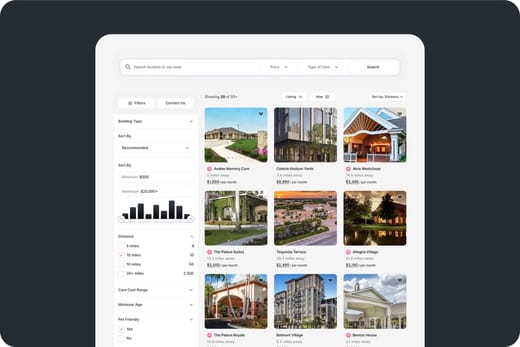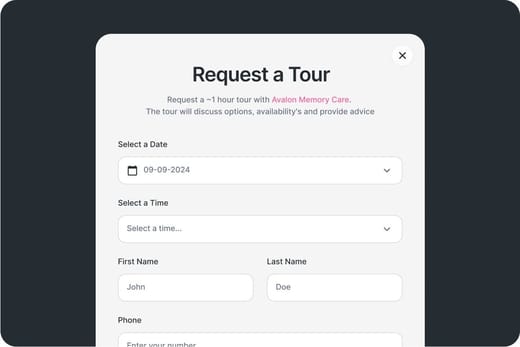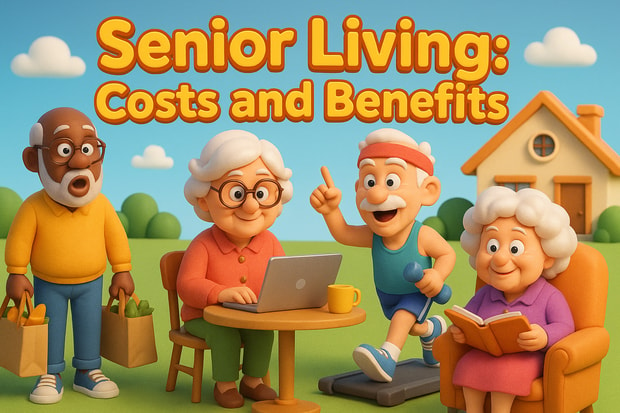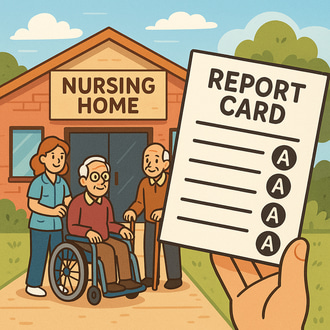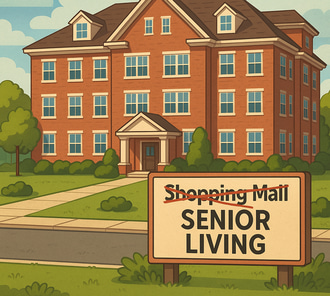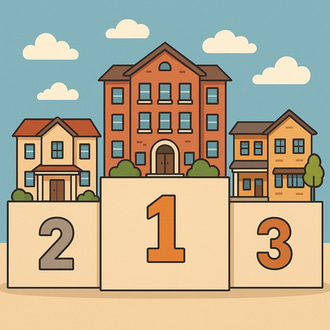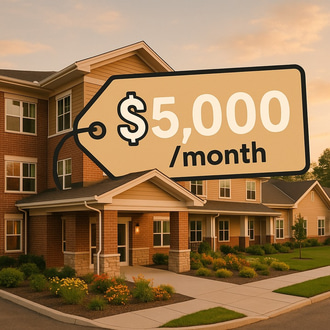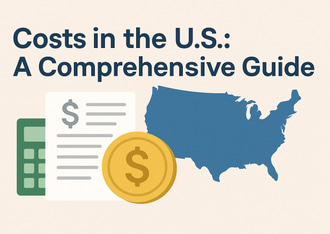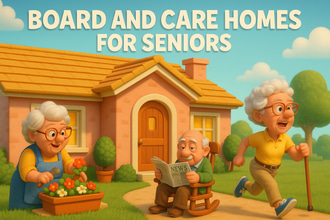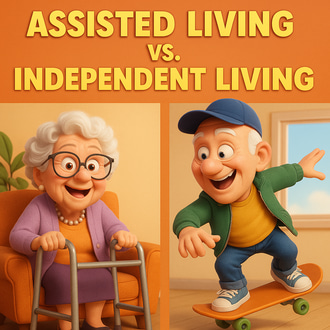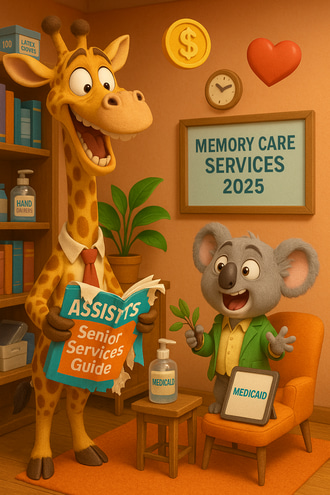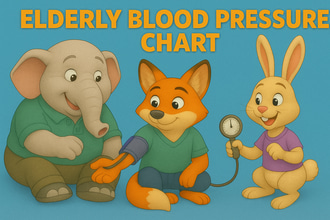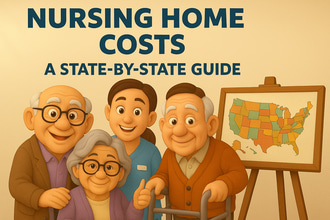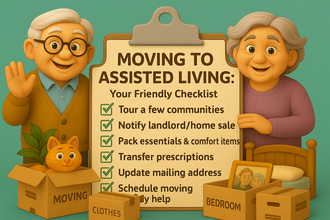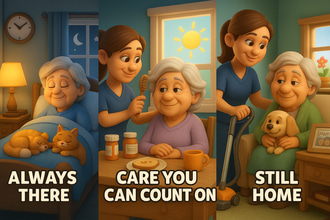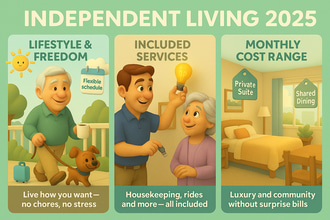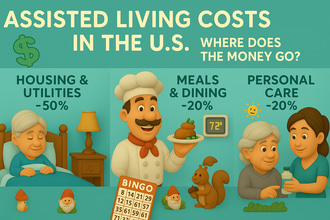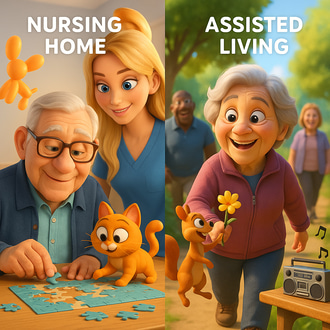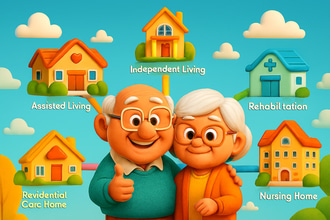Senior living is a care option for older adults, 55+, providing a variety of housing with different levels of care. These options satisfy older adults’ needs and preferences, typically providing support for ADLs, social engagement, and maintaining their independence. This article aims to provide a comprehensive overview of senior living, its services, costs, and benefits of different communities.
What is Senior Living?
Senior living includes a wide range of residential options, providing different levels of care and lifestyle preferences. Typically provides housing, support services, and health care for older adults who need support with daily activities and ease the burdens of homeownership, as per the National Institute on Aging. The primary types of senior living are the following:
- Independent Living
- Catering to active older adults who aim to maintain independence without the burdens of home ownership and maintenance. These communities promote social engagement and wellness and provide private apartments for older adults who require minimal to no assistance with daily activities.
- Assisted Living
- Ideal for older adults who need support for activities of daily living, including bathing, grooming, and medication management. Communities promote a home-like environment while providing personal care, meals, and round-the-clock monitoring.
- Memory Care
- Provides specialized care for older adults with cognitive impairments like Alzheimer’s disease and dementia. Structured routines, secure spaces, and dementia dementia-trained team are provided to ensure comfort and safety.
- Board and Care Homes
- Promotes a home-like setting and provides personal care and meals for at most 20 residents. Typically smaller and has a tight-knit community.
- Continuing Care Retirement Communities (CCRCs)
- Allows older adults to age in place with the continuum of care services, ranging from independent living to assisted living and nursing care.
- Nursing Homes
- Focuses on medical care, providing 24-hour skilled nursing services for older adults with chronic illnesses or for post-hospitalization recovery.
Services
Different types of communities provide a variety of services, promoting a better quality of life to meet older adults’ needs. However, common services include the following, per the Centers for Disease Control and Prevention’s National Survey of Residential Care Facilities (NSRCF).
- Housing and Amenities
- Private or shared apartments, cottages, often equipped with kitchens, accessible bathrooms, and emergency call systems. Most communities provide communal spaces, fitness centers, libraries, and outdoor spaces.
- Personal Care
- ADL support, mobility assistance, and medication management, typically in assisted living, memory care, and care homes.
- Meals and Nutrition
- Three meals daily, plus snacks, are often provided, catering to residents’ dietary needs. Independent living residents may have optional dining plans.
- Medication Management
- Reminds residents to take medications and helps administer them, common in assisted living and board and care homes.
- Health and Wellness
- Usually conducts wellness programs and fitness classes. In some cases, on-site medical staff and coordination with healthcare providers are also available. Nursing homes and some CCRCs focus on skilled nursing care.
- Social and Recreational Activities
- Scheduled activities and programs, including games, outings, arts and crafts, and educational programs, to promote social engagement and enhance cognition.
- Housekeeping and Maintenance
- Regular cleaning, laundry, and home maintenance, encouraging residents to focus on enjoying their lifestyle.
- Transportation
- Scheduled transportation for medical appointments and errands.
- Security and Supervision
- 24-hour supervision and monitoring, emergency response systems, and, in memory care, secure environments to prevent wandering.
According to the NSRCF, 90% of residential care communities, including assisted living and board and care homes, provide ADL support, while 75% offer medication management, emphasizing personalized care.
Costs of Senior Living
Several factors, including location, level of care, and amenities, influence the costs of senior living. Below is an overview of average costs, with reference to government data and trusted industry sources:
- Independent Living: $1,500 to $4,000 per month. Costs are lower due to the level of care provided.
- Assisted Living: $4,500 to $7,000 per month. Additional fees are charged for medication management and extra ADLs.
- Memory Care: $6,000 to $9,000 per month. Costs include specialized care for cognitive conditions and purposely designed amenities.
- Board and Care Homes: $2,500 to $7,000 per month. Room type, level of care, and amenities affect the costs of care homes.
- CCRCs: $2,500 to $10,000 per month, plus entrance fees ranging from $100,000 to $1 million, for future levels of care. Costs vary based on the level of care and contract type, such as life care or fee-for-service.
- Nursing Homes: $8,000 to $12,000 per month. The most expensive option is due to the level of care provided, usually with licensed professionals like nurses and doctors.
Payment Options
A combination of these options may be used to cover expenses:
- Private Pay: Savings, pensions, retirement accounts, or home sale proceeds are the most common funding sources.
- Long-Term Care Insurance: Depending on the plan, some policies cover assisted living, memory care, or board and care homes.
- Medicaid: Varying by state, Medicaid waivers can cover some services, though board and room are rarely covered. Medicaid fully covers nursing home care for eligible low-income older adults.
- Medicare: Covers short-term skilled nursing or rehabilitation after a hospital stay of up to 100 days.
- Veterans Benefits: The U.S. Department of Veterans Affairs provides Aid and Attendance benefits to help eligible veterans and spouses cover senior living expenses.
- HUD Programs: The U.S. Department of Housing and Urban Development offers subsidized housing options for low-income older adults for affordable housing and some independent living communities.
Benefits
- Safety and Security: Emergency call systems, 24-hour staff, and accessibility features, including grab bars and wheelchair-accessible accommodations. Memory care units are usually secure and gated to prevent wandering.
- Social Engagement: Recreational activities are curated to promote social interactions and wellness, alongside cozy communal spaces.
- Personalized Care: Tailored assistance for ADLs and health needs to maintain older adults’ dignity.
- Maintenance-Free Lifestyle: Housekeeping, laundry, maintenance, and meal preparation allow older adults to relax and enjoy recreational activities.
- Access to Healthcare: Nursing homes and CCRCs provide nursing care, while most communities provide coordination with healthcare providers.
- Cost Predictability: Most communities offer all-inclusive rates, allowing clear budgeting, in contrast to maintaining a private home with separate care services.
Considerations
- Assess Needs: Evaluate physical, cognitive, and social needs to ensure the right level of care is provided.
- Visit Communities: Tour multiple facilities, including non-scheduled visits, observe staff-resident interactions, and verify services, costs, and policies.
- Verify Licensing: Check state licensing and review inspection reports through local agencies.
- Understand Costs: Clarify all fees, including additional charges for care services, and research for possible funding options to optimize resources.
- Seek Feedback: Talk to current residents and families about their experiences.
Conclusion
Senior living provides a wide range of care options for older adults, varying in the level of care, type of housing, and amenities provided. Costs are affected by location, level of care, and community type, and usually range from $1,500 to $12,000 per month. Government funding, like Medicaid, VA Benefits, and Medicare, may help cover senior living expenses, alongside private insurance and savings. Older adults enjoy plenty of benefits, including comfort, safety, convenience, personalized care, and social engagement. However, they have to take into consideration their needs, budgets, and preferences to ensure the right type of senior living is chosen. Research and touring will help families and older adults evaluate the available options and create a long-term care plan that best adheres to their needs and financial capabilities.

